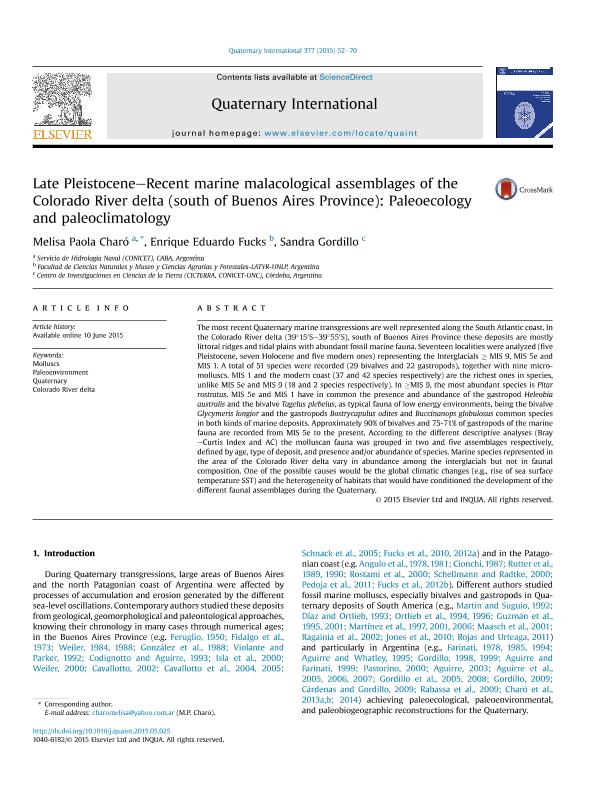Mostrar el registro sencillo del ítem
dc.contributor.author
Charo, Melisa Paola

dc.contributor.author
Fucks, Enrique Eduardo

dc.contributor.author
Gordillo, Sandra

dc.date.available
2020-03-04T21:34:37Z
dc.date.issued
2015-08
dc.identifier.citation
Charo, Melisa Paola; Fucks, Enrique Eduardo; Gordillo, Sandra; Late Pleistocene-Recent marine malacological assemblages of the Colorado River delta (south of Buenos Aires Province): Paleoecology and paleoclimatology; Pergamon-Elsevier Science Ltd; Quaternary International; 377; 8-2015; 52-70
dc.identifier.issn
1040-6182
dc.identifier.uri
http://hdl.handle.net/11336/98810
dc.description.abstract
The most recent Quaternary marine transgressions are well represented along the South Atlantic coast. In the Colorado River delta (39°15'S-39°55'S), south of Buenos Aires Province these deposits are mostly littoral ridges and tidal plains with abundant fossil marine fauna. Seventeen localities were analyzed (five Pleistocene, seven Holocene and five modern ones) representing the Interglacials ≥ MIS 9, MIS 5e and MIS 1. A total of 51 species were recorded (29 bivalves and 22 gastropods), together with nine micromolluscs. MIS 1 and the modern coast (37 and 42 species respectively) are the richest ones in species, unlike MIS 5e and MIS 9 (18 and 2 species respectively). In ≥MIS 9, the most abundant species is Pitar rostratus. MIS 5e and MIS 1 have in common the presence and abundance of the gastropod Heleobia australis and the bivalve Tagelus plebeius, as typical fauna of low energy environments, being the bivalve Glycymeris longior and the gastropods Bostrycapulus odites and Buccinanops globulosus common species in both kinds of marine deposits. Approximately 90% of bivalves and 75-71% of gastropods of the marine fauna are recorded from MIS 5e to the present. According to the different descriptive analyses (Bray-Curtis Index and AC) the molluscan fauna was grouped in two and five assemblages respectively, defined by age, type of deposit, and presence and/or abundance of species. Marine species represented in the area of the Colorado River delta vary in abundance among the interglacials but not in faunal composition. One of the possible causes would be the global climatic changes (e.g., rise of sea surface temperature SST) and the heterogeneity of habitats that would have conditioned the development of the different faunal assemblages during the Quaternary.
dc.format
application/pdf
dc.language.iso
eng
dc.publisher
Pergamon-Elsevier Science Ltd

dc.rights
info:eu-repo/semantics/openAccess
dc.rights.uri
https://creativecommons.org/licenses/by-nc-nd/2.5/ar/
dc.subject
COLORADO RIVER DELTA
dc.subject
MOLLUSCS
dc.subject
PALEOENVIRONMENT
dc.subject
QUATERNARY
dc.subject.classification
Paleontología

dc.subject.classification
Ciencias de la Tierra y relacionadas con el Medio Ambiente

dc.subject.classification
CIENCIAS NATURALES Y EXACTAS

dc.title
Late Pleistocene-Recent marine malacological assemblages of the Colorado River delta (south of Buenos Aires Province): Paleoecology and paleoclimatology
dc.type
info:eu-repo/semantics/article
dc.type
info:ar-repo/semantics/artículo
dc.type
info:eu-repo/semantics/publishedVersion
dc.date.updated
2020-02-26T15:04:23Z
dc.journal.number
377
dc.journal.pagination
52-70
dc.journal.pais
Países Bajos

dc.journal.ciudad
Amsterdam
dc.description.fil
Fil: Charo, Melisa Paola. Ministerio de Defensa. Armada Argentina. Servicio de Hidrografía Naval; Argentina. Consejo Nacional de Investigaciones Científicas y Técnicas; Argentina
dc.description.fil
Fil: Fucks, Enrique Eduardo. Universidad Nacional de La Plata. Facultad de Ciencias Agrarias y Forestales; Argentina
dc.description.fil
Fil: Gordillo, Sandra. Consejo Nacional de Investigaciones Científicas y Técnicas. Centro Científico Tecnológico Conicet - Córdoba. Centro de Investigaciones en Ciencias de la Tierra. Universidad Nacional de Córdoba. Facultad de Ciencias Exactas Físicas y Naturales. Centro de Investigaciones en Ciencias de la Tierra; Argentina
dc.journal.title
Quaternary International

dc.relation.alternativeid
info:eu-repo/semantics/altIdentifier/url/https://www.sciencedirect.com/science/article/pii/S1040618215005121
dc.relation.alternativeid
info:eu-repo/semantics/altIdentifier/doi/https://doi.org/10.1016/j.quaint.2015.05.025
Archivos asociados
